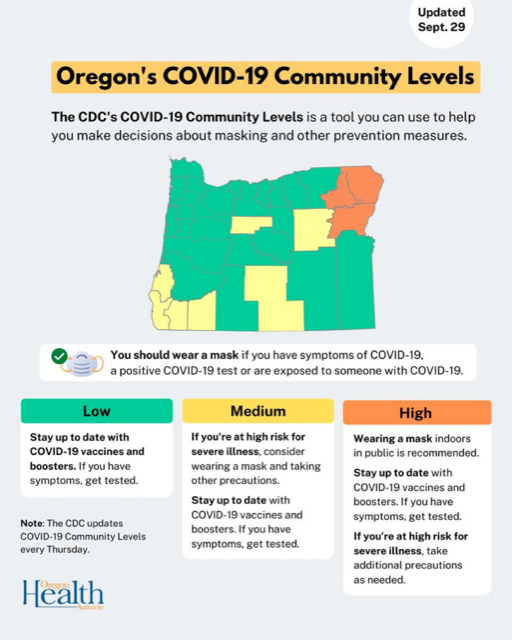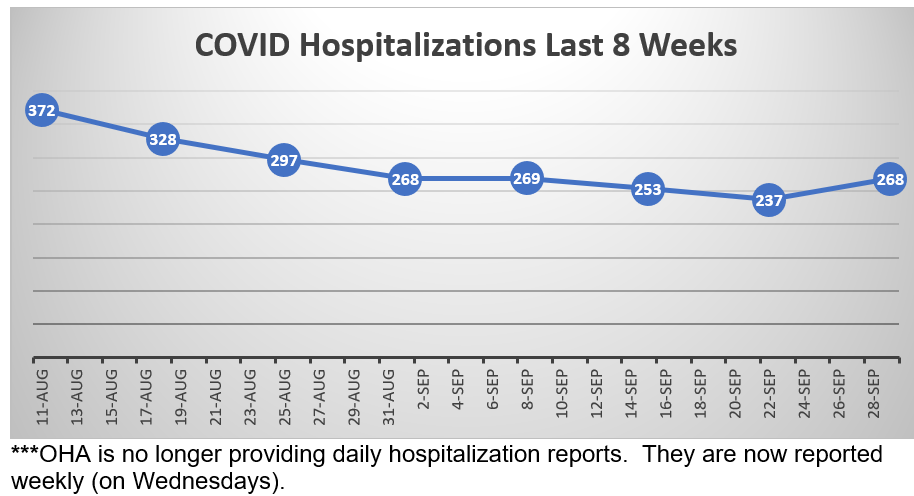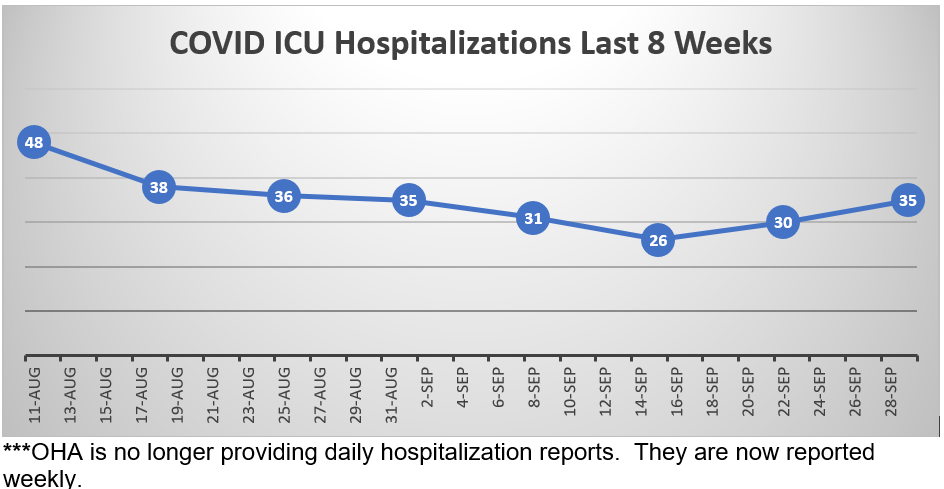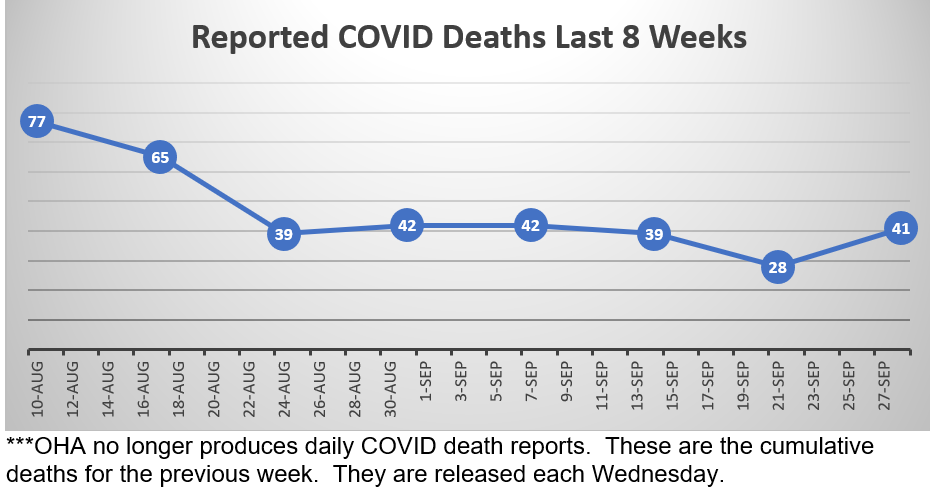|
October 1, 2022
Dear Neighbors and Friends,
I hope that you and your loved ones are doing well, staying healthy, and looking out for your neighbors and friends during this past week.
In this week’s newsletter you’ll find a variety of updates related to legislative workgroups, rental assistance, and healthcare reform.
The news related to wildfires in Oregon is thankfully again positive. I’m not including a specific update on wildfire this week. Fortunately, fall weather conditions appear to be taking over, and all of the fires in the state appear to be completely or largely under control. (Many thanks again to all those still working non-stop to ensure our safety.) For details, you can find the current status reports at the Office of Emergency Management’s wildfire dashboard and at the Northwest InterAgency Coordination blog: http://nwccinfo.blogspot.com/
On the COVID front, most of the COVID indicators appear to be inching back up this week, though nearly all Oregon counties remain at Low Risk. You’ll find more details in the summaries, graphs, and links in this week’s newsletter. I was hoping to have the latest forecast from OHSU for you, but it appears to be delayed. I’ll include it in the next newsletter.
Until next time, please do your best to stay healthy and safe. And let me know if you have any questions or thoughts about anything in this week’s newsletter.
Rent Assistance Program Runs Out, But Other Funds May Be Available
At the end of Friday the state program that used federal funds to pay the rent for renters unable to do so, and who would otherwise face eviction, came to an end. This was the Oregon Emergency Rental Assistance Program (OERAP). Because Oregon did such a good job getting resources out the door to those in need, however, we are receiving some of the unspent dollars from other states. They should get here soon. Last week the Emergency Board allocated funds to Oregon Housing and Community Services to keep the program going until those new federal dollars come through. These are intended for Oregonians who applied for relief but have not yet had their applications completely processed. We just learned yesterday that OHCS is also working to find other funds internally to help with this.
Here’s the communication that we received from Andrea Bell, Executive Director of OHCS. It includes information and links that could be of use to you or anyone you know who is still awaiting rental assistance.
If you think you might be eligible for this assistance, please let us know, and we’ll see what we can do to help.
Legislature Receives Report of Joint Task Force on Universal Health Care
Next month Oregonians will be voting on Ballot Measure 111, referred to the voters by the Oregon Legislature. It amends the Constitution to clarify that the state must "ensure that every resident of Oregon has access to cost-effective, clinically appropriate and affordable health care as a fundamental right."
It directs the Legislature to take the next steps to create such access without specifying any particular path to get there. It does not, however, compel the Legislature to meet this goal at the expense of other necessary programs.
As part of this effort, in 2019 the Legislature passed SB 770, thereby creating the Joint Task Force on Universal Health Care. The Task Force was charged with “making recommendations for a functional single-payer health care system that is responsive to the needs of the residents of this state.” The Task Force met for many hours over more than two years, engaging with hundreds of Oregonians around the state. The report recommends that the Legislature create a Governance Board that will develop and oversee the implementation of such a plan by 2026-27. The Task Force, chaired by former DHS/OHA Director Dr. Bruce Goldberg, has found that with the proper implementation, this new universal health care system will cost Oregonians less than the status quo, while providing equitable, high-quality healthcare for all.
You can read the details in the report’s Executive Summary or in the full report itself.
The release of this report and recommendations is an important step in a process that has been underway for years, a process that has been a priority of mine for more than a decade, and whose further steps will come in the 2023 session.
Oregon Receives Groundbreaking Federal Treatment for Its Medicaid Plan
Following up on the above item, the effort of getting to universal healthcare in Oregon will require us to fully utilize and build on the federal programs that are already in place, including Medicaid, Medicare, and care for Veterans. Oregon has always been in the forefront of accessing these benefits to the fullest, and it has just taken a remarkable step further.
Under a new agreement announced on Wednesday, the federal government will give Oregon $1.1 billion to guarantee medical coverage for young children whose families may move in and out of eligibility as their income fluctuates. This will be a benefit to tens of thousands of children. The new agreement also allows for broader use of the program
Under federal $1 billion agreement, Oregon will expand Medicaid coverage to include additional support for food, housing, and other necessities.
You can find more details in Lynne Terry’s fine reportingfine reporting in the Capital Chronicle.
Need Help Navigating Long COVID?
OHA will host a free webinar with information for those concerned about Long COVID. It will address symptoms, treatment, and advocacy tips for Long COVID. It will also cover workplace rights, disability identity, and accommodations. Speakers will include people from OHSU, the Bureau of Labor and Industries (BOLI), and Disabilities Rights Oregon (DRO).
The webinar will be held on October 5 from 1 pm to 3 pm. You can register for it here.
Here's a link with more information about the speakers and to submit questions in advance.
Poultry CAFO Work Group Finishes Its Work
I’ve written before about one of my work groups this summer—the Work Group on Poultry CAFOs (Confined Animal Feeding Operations). The work group was charged with doing a deep dive into the statutes and processes that govern these operations, sparked by concerns raised by neighbors of a newly proposed poultry feeding operation in the mid-Willamette Valley. If it receives all its permits and begins operation, it will house nearly a million chickens at a time.
The work group included legislators from both chambers and both parties, county commissioners, neighbors, poultry industry reps, broader agriculture industry reps, environmentalists, and agency representatives there to support our work. I served as Chair.
The work group had its fifth and final meeting during the week of Legislative Days. I then reported on its findings to the Senate Committee on Natural Resources and Wildfire Recovery. I told them about the contents of the five meetings and steered them to the workgroup website:
- Meeting One: Focused on the CAFO process in general, and learned more about how an analysis of air and water quality are part of that process.
- Meeting Two: How CAFO intersect with Oregon’s land use system and the role of counties in that process; a presentation on the poultry industry in the Northwest
- Meeting Three: Water quantity challenges (impact of large new water consumers on aquifers already stressed by climate change)
- Meeting Four: Public Testimony. You can see written testimony on the website. Nearly all of it related to concerns around the potential impacts of big poultry CAFOs on neighbors and aquifers.
- Meeting Five: Observations and Recommendations from Committee Members
Here were some of the observations that I shared with them:
- We were asked by the poultry industry not to conflate the facilities here in Oregon with facilities in the East and South. Ours are newer and under stricter regulation.
- DEQs ability to regulate potential discharges into water appears adequate. Unlike dairy effluent, chicken manure is dry and easier to control.
- CAFOs are considered agricultural operations, and as such are not subject to the same level of scrutiny by the state or county that industrial operations are.
- We were asked by the County Commissioners to allow counties to play a greater role in setting the conditions under which large CAFOs function.
- One interesting parallel here may be with cannabis farms. The Legislature decided that cannabis operations are agriculture and enjoy the rights of other farming operations. However, counties are able to set conditions on their hours of operation, proximity to schools, setbacks, and others.
- Impact on air quality came up as a concern, but DEQ has not developed standards for CAFOs (nor has the federal government, though it appears that the EPA may be close to setting some after years in the making).
- We heard about the consensus recommendations that came out of the 2007 Dairy Air study. That task force recommended a process that would have created and monitored standards, but the program never was funded by the Legislature. It was recommended that the Legislature do so.
- Finally, we heard a number of concerns and recommendations related to the Stockwater Exemption. This is a feature of our water law, a holdover from earlier days, that allows farmers to use an unlimited and unmetered amount of water (surface and underground water) for their animals, irrespective of the potential impact on the surrounding aquifer. Recommendations included mandatory metering and reporting for new operations, limitations on use, and greater transparency with neighbors.
The Senate Committee on Natural Resources and Wildfire Reduction will next consider what it intends to do with the work group’s research and reporting, including potential legislation. I may myself convene another group to look specifically at the Stockwater Exemption issue prior to the session.
You can find all the meeting materials and recordings at the Workgroup website.
And here’s a writeup on the committee hearing from Alex Baumhart at the Capital Chronicle.
ON THE COVID FRONT
Weekly Data Report:
As I mentioned in my last newsletters, OHA is no longer providing COVID updates on a daily basis. Instead, the data will be provided only on a weekly basis, on Wednesdays (as they already have for hospitalizations).
Here are the last set of daily results, for this past week from 9/22/22 through 9/28/22.
As you’ll see, all but the first metric increased last week.
- The 7-day average for last week decreased to 614 per day (vs. 657 the previous week). The number of new cases is again likely an undercount, as many people are using home tests to determine their infection status but are not reporting those results.
- Average test positivity for the last week was 9.3%, vs. 8.7% the previous week. Again, this number skews high because it likely reflects a higher proportion of people showing COVID symptoms (and thus going in for a test, rather than self-testing).
- On Wednesday there were 268 COVID-19-related hospitalizations statewide, vs. 237 last Wednesday. Hospitalizations are now our best indicator of disease spread. Again, however, most of these hospitalizations are not in and of themselves due to COVID—more than half are those who tested positive after having been admitted for other reasons.
- The number of COVID patients in Oregon’s ICUs has again gone up over the last week: 35 on Wednesday, up from last week’s 30. These are the most serious COVID infections.
- There were 41 COVID-19-related deaths reported during the last week, up from last week’s 28. Again, if you look at the graph at the end of the newsletter showing deaths when they actually occurred, many of these reported deaths actually occurred in earlier weeks but were just reported to the state.
Weekly County Report: Three NE Oregon Counties at High Risk
The CDC assigns risk levels based on a combination of the number of new COVID cases and the number of people in hospital for COVID.
According to the CDC Daily Counter (updated each Thursday), three Oregon counties, all in the northeastern corner of the state, are currently at High Risk: Baker, Union, and Wallowa.
Seven Oregon counties (down from 9 last week) have reported infection rates that place them in the Medium Risk category: Coos, Curry, Grant, Jackson, Jefferson, Josephine, and Lake.
Twenty-six Oregon counties (down from 29 last week)— Benton, Clackamas, Clatsop, Columbia, Crook, Deschutes, Douglas, Gilliam, Harney, Hood River, Klamath, Lane, Lincoln, Linn, Malheur, Marion, Morrow, Multnomah, Polk, Sherman, Tillamook, Umatilla, Wasco, Washington, Wheeler, and Yamhill—are at Low Risk.
We can also track the cases, deaths, and test positivity rates for each county at this website.
Although they have remained in Low Risk status for some time now, the three Portland-area counties did show increases in positivity rates from the previous week. At 8.8%, Multnomah County is up from last week’s 8.1. Washington County is now at 9.1%, up from 8.1%. Clackamas County is 9.3%, up from last week’s 8.7%.

This Week’s Wastewater Monitoring Report Shows More Decreases, But Mainly Plateaus in Oregon Cities
With testing reports giving us just a fraction of infections out there, wastewater monitoring has become a more reliable indicator of the amount of virus in cities around the state. That report is updated each week.
This week’s report shows us that more cities are showing decreases. Twenty-five percent (up from 18%) of the cities monitored showed decreases or sustained decreases; six percent (up from 5) showed increases (same as last week), and 72% (same as last week) showed no change.
From OHA: Q&A with Drs. Paul Cieslak and Tim Menza
Dr. Paul Cieslak, OHA senior health advisor and medical director, communicable diseases and immunizations program, OHA’s Office of Recovery and Resilience and Dr. Tim Menza, OHA senior health advisor, answered this week’s questions.
Q: Are there any online support groups or resources for people with underlying conditions who must continue to practice social distancing, masking and avoiding indoor crowds? It's very lonely at times. It would be great to talk to others like us. – Holly, Milwaukie
A: “Thank you for writing, and know that you are not alone. Thousands of people in Oregon live with underlying conditions and are likely feeling the same loneliness. Here are a few resources that might be able to help you.”
- The Safe + Strong Helpline. Call 1-800-923-4357 (available 24/7).
- The Global Healthy Living Foundation offers a free COVID-19 support programfor people who have chronic diseases and their families.
- The National Alliance on Mental Illness offers free online support groups and other programs. Here’s a link to its programs in Clackamas County.
-
Peer Galaxyis an online portal to hundreds of online and in-person support groups in Oregon. Check out their calendar of events.
- Community Counseling Solutions offers free phone support from the David Romprey Oregon Warmline, for anyone: 1-800-698-2392 (available daily, 9 a.m. to 11 p.m.).
-
Reach Out Oregon, which provides mental, behavioral and emotional support, has a warm line: 1-833-732-2467, available (Mon. to Fri., noon to 7 p.m.).
Q: Does my childhood smallpox vaccination protect me from monkeypox? – Mary, Eugene
A: “Vaccination against smallpox within the previous 10 years probably provides significant protection against monkeypox. But the immunity wanes over time, so beyond that, one can’t be sure. If you’re at risk for monkeypox, we’d recommend the two-dose JYNNEOS vaccine.”
You’re eligible for a JYNNEOS vaccine if:
- A public health official has informed you that one of your contacts has monkeypox.
- You have had recent close contact with someone with monkeypox.
- You anticipate having, or have had, recent skin-to-skin contact with at least one other person AND you know other people in your community who have had monkeypox.
- You work in a laboratory doing monkeypox virus testing, or if you work in a laboratory and have had an exposure. For example, you examined monkeypox lesions or collected monkeypox specimens without using recommended personal protective equipment.
Q: I have two questions. As an almost 80-year-old who is totally vaccinated and will continue to vaccinate in the fall, but also as someone with asthma, should I continue to mask? I pick up my grandkids after school. Also I’m concerned about polio. Are you monitoring for that? As someone who had the first polio vaccine to be developed, should my husband and I be revaccinated? – Barbara, Tigard
A: “To your first question, COVID-19 continues to be transmitted at high rates, and it’s very likely it’s being spread among kids at your grandkids’ school. Your immunity, even with the boosters, probably waned significantly by a few months after your last booster, so you’re at some risk of getting COVID-19. Masking—especially with an N95 or KN95 mask--will reduce (but not eliminate) your chances of getting COVID-19. If you’re worried about it and willing to wear the mask, we’d recommend that you do so.
“Regarding polio, it is reportable in Oregon, and no cases have been reported here since 1983. We are not monitoring wastewater for polio, as they are apparently doing in New York City. We would not recommend that you receive another polio vaccine unless you plan to travel to a country that is experiencing cases of polio.”
If you have a question about COVID-19 or other public health topics, submit your question here. While we are unable to answer every question, we try to address questions of interest to a broad audience. Please understand we are unable to provide specific medical advice for personal medical conditions."
Additional COVID Updates and Links
- Here’s the latest on COVID in Oregon from the Oregonian.
- COVID cases are rising in the UK as fall begins. If past trends hold true, that means we can anticipate that the same may happen here.
- On the other hand, the U.S. is benefiting from the new bivalent vaccines, which might make a difference. I reported last week that more than 4 million Americans had received the vaccine so far. Last week that number nearly doubled, as 3.2 million additional Americans were vaccinated, bringing the total to 7.6 million as of September 28. That’s good news, but we have a long way to go: The 7.6 million figure represents only 3.5% of the 215.5 million people in the United States aged 12 or older who are eligible to receive the shots because they have completed their primary vaccination series. Here's more.
- In another marker in the course of the pandemic, the CDC has issued a new guidance on masking: it's no longer recommending masking, in healthcare settings, except in areas at High Risk for transmission.
- How are healthcare workers reacting to the new CDC guidance that masking is no longer needed in healthcare settings? They're not happy.
- Not surprisingly, the President’ s statement two weeks ago about the pandemic being essentially over is still causing ripples. Is COVID “under control” in the U.S.? In this article from Politifact (reprinted in the Oregon Capital Chronicle), experts say yes.
- A new study of U.S. veterans shows that long-term neurological problems (including memory loss, movement disorder, seizures, and strokes) rose by 7% after a COVID infection.
- The Washington Post gives us five things we still don't understand about this pandemic—at our own peril if we want to defend ourselves from the next.
- And here’s one from the New York Times arguing that the slow response to monkeypox has revealed ongoing weaknesses in our public health response. [Notice: access to this article may require a subscription.]
- Hospitals have been relying heavily on expensive travel nurses during recent staff shortages. The nurses are paid much more than their incumbent nurses, which causes resentment and is a financial burden on hospital systems. But we’re learning that it’s not necessarily working out well for the travel nurses themselves: many are seeing their pay quickly slashed in a "bait-and-switch" tactic.
- The latest edition of the Journal of the American Public Health Association features a section with several interesting articles on COVID and the impact of health equity gaps on various communities.
- A new paper in the Journal of the American Medical Association shows the close relationship between COVID and deaths by cancer during the first year of the pandemic.








Here again are some COVID resources that you will find useful:
If the above links are not providing you with answers to your questions or directing you to the help that you need, please consider me and my office to be a resource. We’ll do our best to assist you or steer you in the right direction.
Want to See Past Newsletters?
If there was COVID-related information in a past newsletter that you want to go back to, but find you’ve deleted it, you can always go to my legislative website (senatordembrow.com), click on “News and Information,” and you’ll find them all there. Also, if someone forwarded you this newsletter and you’d like to get it directly, you can sign up for it there.
Best,
 Senator Michael Dembrow
District 23
email: Sen.MichaelDembrow@oregonlegislature.gov
web: www.senatordembrow.com
phone: 503-281-0608
mail: 900 Court St NE, S-407, Salem, OR, 97301
|